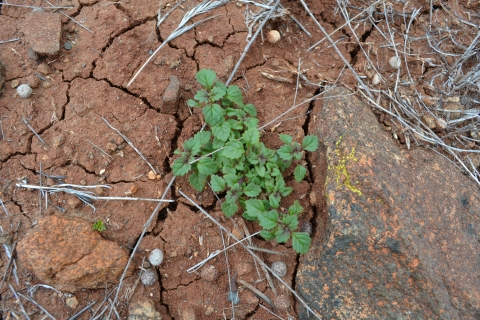| Plant Type: Annual Herb |
| Height: 1.9 - 5.9 in tall |
| Flower Color: White, Purple, Pink |
Listing Status
San Diego thornmint was listed as endangered by the State of California in 1982 and listed as threatened by the Service on October 13, 1998. Currently, the greatest threat to San Diego thornmint is the invasion by non-native plants in the open areas that support this species. When exotic plant species become established, they can outcompete San Diego thornmint for light, water, nutrients, and space. Another threat to this species is trampling of vegetative material, compaction of soil, and ongoing recreational activities in areas with extant populations of thornmint. Fire also poses a threat to this species’ habitat.
Description
San Diego thornmint flowers from April to May and remains erect, retaining its distinct shape well into the dry season. San Diego thornmint is an outcrosser that is pollinated by insects; however, information regarding the plant’s breeding system is limited. Populations of this species range from just a few individuals to several thousand plants. The majority of the known populations range from 50 to 2,000 plants. The abundance of standing individuals of San Diego thornmint fluctuates annually at each occurrence. At occurrences surveyed over a number of years, the size of an occurrence can differ by an order of magnitude.
Range
This species, which can be found at elevations that range from sea level to 3,000 feet (915 meters), is endemic to San Diego County, California and northwestern Baja California, Mexico.
Habitat
Populations of San Diego thornmint generally occur in openings within coastal sage scrub, chaparral, and native grassland habitats, where isolated patches of clay soils, referred to as “clay lenses,” are present. In fact, San Diego thornmint is believed to be restricted to gabbro soils derived from igneous rock and gray calcareous clay soils derived from soft calcareous sandstone. The open areas of clay lenses where San Diego thornmint occurs can generally be described as areas of southeast- to west-facing gentle slopes with friable soil, meaning that the soil has a loose, crumbly texture.
Refuge Occurrence
San Diego thornmint is present in at least three locations on McGinty Mountain. An additional population is located immediately adjacent to the Refuge on land owned by The Nature Conservancy. The third Refuge population was identified in 2011 by San Diego Natural History Museum personnel during surveys conducted in association with the San Diego Plant Atlas. This previously unrecorded population appears to consist of 6,000 to 7,000 plants.
The Otay-Sweetwater Unit includes portions of Unit 4 (Subunits 4A and 4C), which have been identified as some of the most stable populations of San Diego thornmint. Units 4A and 4C are located on southwestern slope of McGinty Mountain. These critical habitat areas need special management to address threats to these populations from exotic plant species and recreational activities.




